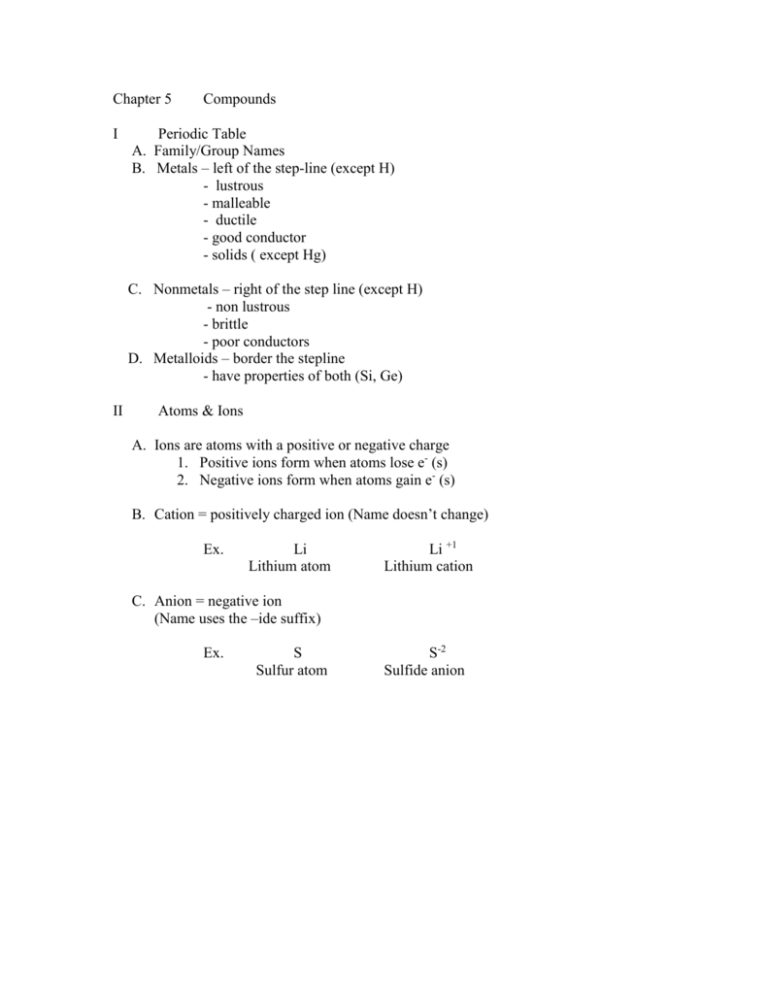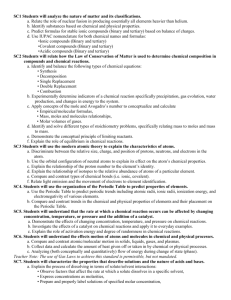Compounds
advertisement

Chapter 5 I Compounds Periodic Table A. Family/Group Names B. Metals – left of the step-line (except H) - lustrous - malleable - ductile - good conductor - solids ( except Hg) C. Nonmetals – right of the step line (except H) - non lustrous - brittle - poor conductors D. Metalloids – border the stepline - have properties of both (Si, Ge) II Atoms & Ions A. Ions are atoms with a positive or negative charge 1. Positive ions form when atoms lose e- (s) 2. Negative ions form when atoms gain e- (s) B. Cation = positively charged ion (Name doesn’t change) Ex. Li Lithium atom Li +1 Lithium cation C. Anion = negative ion (Name uses the –ide suffix) Ex. S Sulfur atom S-2 Sulfide anion III Compounds A. Compound – two or more atoms of different element united in a fixed ratio B. Molecular/Covalent Compounds 1. composed of 1 or more nonmetals 2. smallest unit is a molecule 3. low m.p. & b.p. 4. gases & liquids @ room temp. Ex. H2O Water H2O2 Hydrogen Peroxide *** Change ratio = Change in properties C. Ionic Compounds 1. 2. 3. 4. composed of a metal & nonmetal(s) smallest unit is a formula unit high m.p. & b.p. solids @ room temp. Ex. IV NaCl - Sodium Chloride CuO - Copper Oxide Chemical Formulas A. Chemical Formulas (Emperical) - shows the kinds & numbers of atoms in the smallest representative unit 1. Molecular Formula – shows the no. & type of atoms in a molecule of a covalent compound 2. Formula Unit – shows the lowest ratio of ions in an ionic compound **B. Diatomic Elements – there are seven elements that are diatomic when they are free in nature Mr. “Brinclhof” Br2 I2 N2 Cl2 H2 O2 F2 V Laws of Definite & Multiple Proportions See Vocabulary A. Definite : in a sample of any compound the masses of the elements are always in the same proportions. B. Multiple : whenever two elements form more than one compound, the different masses of one element will combine with same mass of another element in simple whole numbers. (Allotropes) VI Ionic Compounds (Metal & Nonmetal) A. Binary Ionic 1. Naming: Ex. Metal Nonmetal -ide suffix NaCl Sodium Chloride Li2O Lithium Oxide 2. Formulas ( Compounds must be electrically neutral) a. Metal / Nonmetal b. Check Charges c. Balance Charges Ex. Lithium Chloride Lithium Sulfide Calcium Oxide Calcium Fluoride Aluminum Oxide Li+1 Li+1 Ca+2 Ca+2 Al+3 Cl-1 S-2 O-2 F-1 O-2 LiCl Li2S CaO CaF2 Al2O3 B. Transition Metals – most form more than one type of ion 1. Naming: a. The OLD method uses the suffixes with the elements classical name. i. – ous with the lower of two ionic charges ii – ic with the higher of two ionic charges b. The Preferred method uses the Stock Name - a Roman Numeral in parenthesis is part of the name - it actually indicates the charge on the metal Ex.. Fe+2 O-2 Iron (II) Oxide Fe+3 O-2 Iron (III) Oxide 2. Formulas – the Roman Numeral is the charge on the transition metal Ex. Copper (I) Oxide Copper (II) Oxide Cu+1 O-2 Cu+2 O-2 Cu2O CuO C. Polyatomic Ions – a group of atoms that act as a unit and carry a charge. 1. most end in – ite or –ate 2. –ite indicates one less o atom than -ate 3. Exceptions: Ammonium Hydroxide Cyniide NH4 +1 OH-1 CN-1 4. See Back of Table 5. Naming: +Ion - Ion 6. Formulas: When more than one polyatomic ion is needed use parentheses around the polyatomic ion and then the new subscript Ex. VII Calcium Nitrate Ammonium Sulfide *** Copper (II) Hydroxide Ca+2(NO3)2 (NH4)2 Cu+2(OH)2 Binary Molecular Compounds (AKA Covalent Compounds) - Share pair(s) of eto obtain a Noble Gas e- structure A. Name prefixes are used to indicate the number of atoms 1. If there is only one atom of the first element, there is no prefix. 2. The second element always has a prefix and ends in –ide Ex. NO2 N2 O2 Nitrogen dioxide Dinitrogen dioxide *** Prefixes are on the back of the P.T. *** B. Formulas – the prefix is that elements subscript. Ex. Dinitrogen monoxide - N2O Sulfur hexafluoride SF6 *** 1 is never written as a subscript VIII Common Acids- acids are given special treatment when naming See list of common acids on table IX Diatomic Elements – 7 elements that are diatomic when free in nature (covalent bond) Mr. “Brinclhof” Br2 I2 N2 Cl2 H2 O2 F2 *** Electron Dot Structures – or Lewis Dot Structures. A. Diagrams used to show the bonding between atoms. B. Shows only outer electrons C. L.D.S. for elements have the same L.D.S. as the top member of its family. D. L.D.S. for compounds 1. Determine the total number of outer electrons (Use Roman Numerals) 2. Determine which element has the most number of single electrons (this element determines the shape) Write this element down first 3. Position bonds where the single electrons are located. 4. Attach remaining atoms & position any paired electrons. Chapter 5 I Compounds Periodic Table A. Family/Group Names B. _______________ – left of the step-line (except H) - lustrous - malleable - ductile - good conductor - solids ( except Hg) C. ____________________ – right of the step line (except H) - non lustrous - brittle - poor conductors D. _____________________ – border the stepline - have properties of both (Si, Ge) II Atoms & Ions A. Ions are atoms with a positive or negative charge 1. Positive ions form when atoms lose e- (s) 2. Negative ions form when atoms gain e- (s) B. __________________ = positively charged ion (Name doesn’t change) Ex. Li Lithium atom Li +1 Lithium cation C. _____________________ = negative ion (Name uses the –ide suffix) Ex. S Sulfur atom S-2 Sulfide anion III Compounds A. ___________________________ – two or more atoms of different element united in a fixed ratio B. Molecular/Covalent Compounds 1. composed of 1 or more nonmetals 2. smallest unit is a molecule 3. low m.p. & b.p. 4. gases & liquids @ room temp. Ex. H2O Water H2O2 Hydrogen Peroxide *** Change ratio = Change in properties C. ___________________ Compounds 1. composed of a metal & nonmetal(s) 2. smallest unit is a formula unit 3. high m.p. & b.p. 4. solids @ room temp. Ex. IV NaCl CuO Chemical Formulas A. Chemical Formulas (Emperical) - shows the kinds & numbers of atoms in the smallest representative unit 1. ______________________________ – shows the no. & type of atoms in a molecule of a covalent compound 2. ______________________________ – shows the lowest ratio of ions in an ionic compound **B. ______________________________ – there are seven elements that are diatomic when they are free in nature Mr. “Brinclhof” Br2 I2 N2 Cl2 H2 O2 F2 V Laws of Definite & Multiple Proportions See Vocabulary A. ____________________________ : in a sample of any compound the masses of the elements are always in the same proportions. B. _____________________________ : whenever two elements form more than one compound, the different masses of one element will combine with same mass of another element in simple whole numbers. (Allotropes) VI Ionic Compounds (Metal & Nonmetal) A. Binary Ionic 1. Naming: Ex. Metal Nonmetal -ide suffix NaCl Sodium Chloride Li2O Lithium Oxide 2. Formulas ( Compounds must be electrically neutral) a. Metal / Nonmetal b. Check Charges c. Balance Charges Ex. Lithium Chloride Lithium Sulfide Calcium Oxide Calcium Fluoride Aluminum Oxide Li+1 Li+1 Ca+2 Ca+2 Al+3 Cl-1 S-2 O-2 F-1 O-2 LiCl Li2S CaO CaF2 Al2O3 B. ___________________________________ – most form more than one type of ion 1. Naming: a. The OLD method uses the suffixes with the elements classical name. i. – ous with the lower of two ionic charges ii – ic with the higher of two ionic charges d. The Preferred method uses the Stock Name - a Roman Numeral in parenthesis is part of the name - it actually indicates the charge on the metal Ex.. Fe+2 O-2 Iron (II) Oxide Fe+3 O-2 Iron (III) Oxide 2. _________________________ – the Roman Numeral is the charge on the transition metal Ex. Copper (I) Oxide Copper (II) Oxide Cu+1 O-2 Cu+2 O-2 Cu2O CuO C. _______________________________ – a group of atoms that act as a unit and carry a charge. - most end in – ite or –ate –ite indicates one less o atom than -ate Exceptions: Ammonium Hydroxide Cyniide - NH4 +1 OH-1 CN-1 See Back of Table Naming: +Ion - Ion Formulas: When more than one polyatomic ion is needed use parentheses around the polyatomic ion and then the new subscript Ex. Calcium Nitrate Ammonium Sulfide *** Copper (II) Hydroxide Ca+2(NO3)2 (NH4)2 Cu+2(OH)2 VII Binary Molecular Compounds (AKA Covalent Compounds) - Share pair(s) of eto obtain a Noble Gas e- structure A. Name prefixes are used to indicate the number of atoms 3. If there is only one atom of the first element, there is no prefix. 4. The second element always has a prefix and ends in –ide Ex. NO2 N2 O2 Nitrogen dioxide Dinitrogen dioxide *** Prefixes are on the back of the P.T. *** B. Formulas – the prefix is that elements subscript. Ex. Dinitrogen monoxide - N2O Sulfur hexafluoride SF6 *** 1 is never written as a subscript VIII __________________________- acids are given special treatment when naming See list of common acids on table IX _________________________ – 7 elements that are diatomic when free in nature (covalent bond) Mr. “Brinclhof” Br2 I2 N2 Cl2 H2 O2 F2 *** Electron Dot Structures – or Lewis Dot Structures. A. Diagrams used to show the bonding between atoms. B. Shows only outer electrons C. L.D.S. for elements have the same L.D.S. as the top member of its family. D. L.D.S. for compounds 1. Determine the total number of outer electrons (Use Roman Numerals) 2. Determine which element has the most number of single electrons (this element determines the shape) Write this element down first 5. Position bonds where the single electrons are located. 6. Attach remaining atoms & position any paired electrons.




